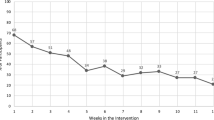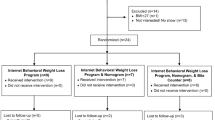Abstract
This study aimed to examine changes in Healthy Eating Index-2010 (HEI-2010) scores, components, and energy intake between automated Bite Counter (Bite) and traditional diet tracking mobile app (App) groups. This was a secondary analysis of the DIET Mobile study, a 6-month weight loss intervention. Assessments were conducted at baseline, 3 and 6 months. Twenty-four-hour dietary recall data were collected. Overweight/obese adults (N = 81) were randomized to Bite or App groups. The intervention was delivered through behavioral podcasts. Participants were provided customized calorie/bite goals and used their device to track intake. We assessed changes in HEI-2010 scores from baseline to 6 months between groups. t tests, chi-square, and repeated measures ANOVA were performed. Models included time, group, and group×time interaction, controlling for no other covariates. There were no significant changes in HEI-2010 scores, components, or energy intake between groups at 3 or 6 months. This study found that both the Bite and App groups were able to reduce their energy intake and there was no difference in changes in diet quality between groups, which provides some support for using the less intensive, more automated method (Bite Counter) for long-term dietary self-monitoring. The study had a low sample size according to power calculations. Future interventions aimed at improving diet quality through mHealth technology should investigate the potential to develop a new app or modify an existing app that would allow for dietary self-monitoring that provides specific feedback on how users’ diets align with diet quality components in the HEI to improve overall diet quality.
Similar content being viewed by others
References
Acharya, S. D., Elci, O. U., Sereika, S. M., Styn, M. A., & Burke, L. E. (2011). Using a personal digital assistant for self-monitoring influences diet quality in comparison to a standard paper record among overweight/obese adults. Journal of the American Dietetic Association, 111(4), 583–588. https://doi.org/10.1016/j.jada.2011.01.009.
Appel, L. J., Moore, T. J., Obarzanek, E., Vollmer, W. M., Svetkey, L. P., Sacks, F. M., et al. (1997). A clinical trial of the effects of dietary patterns on blood pressure. New England Journal of Medicine, 336(16), 1117–1124.
Bandura, A. (2004). Health promotion by social cognitive means. Health Education & Behavior, 31(2), 143–164. https://doi.org/10.1177/1090198104263660.
Boushey, C. J., Spoden, M., Zhu, F. M., Delp, E. J., & Kerr, D. A. (2016). New mobile methods for dietary assessment: review of image-assisted and image-based dietary assessment methods. Proceedings of the Nutrition Society 1–12.
Burke, L. E., Swigart, V., Turk, M. W., Derro, N., & Ewing, L. J. (2009). Experiences of self-monitoring: successes and struggles during treatment for weight loss. Qualitative Health Research, 19(6), 815–828. https://doi.org/10.1177/1049732309335395.
Burke, L. E., Wang, J., & Sevick, M. A. (2011). Self-monitoring in weight loss: a systematic review of the literature. Journal of the American Dietetic Association, 111(1), 92–102. https://doi.org/10.1016/j.jada.2010.10.008.
Carpenter, R. A., Finley, C., & Barlow, C. E. (2004). Pilot test of a behavioral skill building intervention to improve overall diet quality. Journal of Nutrition Education and Behavior, 36(1), 20–26.
Diabetes Prevention Program (DPP). (2002). The diabetes prevention program (DPP). Diabetes Care, 25(12), 2165–2171. https://doi.org/10.2337/diacare.25.12.2165.
Dong, Y., Hoover, A., Scisco, J., & Muth, E. (2012). A new method for measuring meal intake in humans via automated wrist motion tracking. Applied Psychophysiology and Biofeedback, 37(3), 205–215. https://doi.org/10.1007/s10484-012-9194-1.
Guenther, P. M., Casavale, K. O., Reedy, J., Kirkpatrick, S. I., Hiza, H. A. B., Kuczynski, K. J., et al. (2013). Update of the healthy eating index: HEI-2010. Journal of the Academy of Nutrition and Dietetics, 113(4), 569–580.
Hermans, R. C. J., Hermsen, S., Robinson, E., Higgs, S., Mars, M., & Frost, J. H. (2017). The effect of real-time vibrotactile feedback delivered through an augmented fork on eating rate, satiation, and food intake. Appetite, 113, 7–13. https://doi.org/10.1016/j.appet.2017.02.014.
Hingle, M., & Patrick, H. (2016). There are thousands of apps for that: navigating mobile technology for nutrition education and behavior. Journal of Nutrition Education and Behavior, 48(3), 213–218.e1. https://doi.org/10.1016/j.jneb.2015.12.009.
Hu, F. B., Rimm, E. B., Stampfer, M. J., Ascherio, A., Spiegelman, D., & Willett, W. C. (2000). Prospective study of major dietary patterns and risk of coronary heart disease in men. The American Journal of Clinical Nutrition, 72(4), 912–921.
Hutchesson, M. J., Rollo, M. E., Krukowski, R., Ells, L., Harvey, J., Morgan, P. J., … Collins, C. E. (2015). eHealth interventions for the prevention and treatment of overweight and obesity in adults: a systematic review with meta-analysis. Obesity Reviews, 16(5), 376–392. doi: https://doi.org/10.1111/obr.12268
Jakicic, J. M., Tate, D. F., Lang, W., Davis, K. K., Polzien, K., Rickman, A. D., et al. (2012). Effect of a stepped-care intervention approach on weight loss in adults: a randomized clinical trial. JAMA, 307(24), 2617–2626. https://doi.org/10.1001/jama.2012.6866.
Kant, A. K., Schatzkin, A., Graubard, B. I., & Schairer, C. (2000). A prospective study of diet quality and mortality in women. Journal of the American Medical Association, 283(16), 2109–2115.
Kirkpatrick, S. I., Subar, A. F., Douglass, D., Zimmerman, T. P., Thompson, F. E., Kahle, L. L., … Potischman, N. (2014). Performance of the automated self-administered 24-hour recall relative to a measure of true intakes and to an interviewer-administered 24-h recall. The American Journal of Clinical Nutrition, 100(1), 233–240. doi: https://doi.org/10.3945/ajcn.114.083238.
Lehnert, T., Sonntag, D., Konnopka, A., Riedel-Heller, S., & König, H.-H. (2013). Economic costs of overweight and obesity. Best Practice & Research Clinical Endocrinology & Metabolism, 27(2), 105–115. https://doi.org/10.1016/j.beem.2013.01.002.
Ma, Y., Olendzki, B. C., Pagoto, S. L., Hurley, T. G., Magner, R. P., Ockene, I. S., …, Hébert, J. R. (2009). Number of 24-hour diet recalls needed to estimate energy intake. Annals of Epidemiology, 19(8), 553–559. doi: https://doi.org/10.1016/j.annepidem.2009.04.010
Messina, M., Lampe, J., Birt, D., Appel, L., Pivonka, E., Berry, B., & Jacobs, D. (2001). Reductionism and the narrowing nutrition perspective: time for reevaluation and emphasis on food synergy. Journal of the American Dietetic Association, 101(2), 1416–1419.
National Cancer Institute. (2016). Resources realted to the Healthy Eating Index (HEI). Retrieved from http://epi.grants.cancer.gov/asa24/resources/hei.html
Ogden, C. L., Carroll, M. D., Fryar, C. D., & Flegal, K. M. (2015). Prevalence of obesity among adults and youth: United States, 2011–2014. NCHS Data Brief, 219(219), 1–8.
Salley, J. (2013). Accuracy of a bite-count based calorie estimate compared to human estimates with and without calorie information available. Retrieved from http://tigerprints.clemson.edu/all_theses/1680/
SAS Institute Inc. (2013). SAS/STAT (Version 9.4). Cary, NC: SAS Institute Inc.
Scisco, J. L., Muth, E. R., Dong, Y., & Hoover, A. W. (2011). Slowing bite-rate reduces energy intake: an application of the bite counter device. Journal of the American Dietetic Association, 111(8), 1231–1235. https://doi.org/10.1016/j.jada.2011.05.005.
Scisco, J. L., Muth, E. R., & Hoover, A. W. (2014). Examining the utility of a bite-count–based measure of eating activity in free-living human beings. Journal of the Academy of Nutrition and Dietetics, 114(3), 464–469. https://doi.org/10.1016/j.jand.2013.09.017.
Shen, Y., Salley, J., Muth, E., & Hoover, A. (2016). Assessing the accuracy of a wrist motion tracking method for counting bites across demographic and food variables. IEEE Journal of Biomedical and Health Informatics.
Sun, M., Burke, L. E., Mao, Z.-H., Chen, Y., Chen, H.-C., Bai, Y., …, Jia, W. (2014). eButton: a wearable computer for health monitoring and personal assistance. Proceedings / Design Automation Conference. Design Automation Conference, 2014, 1–6. doi: https://doi.org/10.1145/2593069.2596678
Tande, D. L., Magel, R., & Strand, B. N. (2010). Healthy eating index and abdominal obesity. Public Health Nutrition, 13(02), 208. https://doi.org/10.1017/S1368980009990723.
Thomas, J. G., & Bond, D. S. (2014). Review of innovations in digital health technology to promote weight control. Current Diabetes Reports, 14(5), 485. https://doi.org/10.1007/s11892-014-0485-1.
Turk, M. W., Elci, O. U., Wang, J., Sereika, S. M., Ewing, L. J., Acharya, S. D., …, Burke, L. E. (2013). Self-monitoring as a mediator of weight loss in the SMART randomized clinical trial. International Journal of Behavioral Medicine, 20(4). 556–561. doi: https://doi.org/10.1007/s12529-012-9259-9
Turner-McGrievy, G. M., Beets, M. W., Moore, J. B., Kaczynski, A. T., Barr-Anderson, D. J., & Tate, D. F. (2013). Comparison of traditional versus mobile app self-monitoring of physical activity and dietary intake among overweight adults participating in an mHealth weight loss program. Journal of the American Medical Informatics Association, 20(3), 513–518. https://doi.org/10.1136/amiajnl-2012-001510.
Turner-McGrievy, G. M., Wilcox, S., Boutté, A., Hutto, B. E., Singletary, C., Muth, E. R., & Hoover, A. W. (2017). The dietary intervention to enhance tracking with mobile devices (DIET mobile) study: a 6-month randomized weight loss trial. Obesity, 25(8), 1336–1342. https://doi.org/10.1002/oby.21889.
United States Department of Agriculture (USDA). (n.d.). Healthy Eating Index (HEI). Retrieved June 9, 2017, from https://www.cnpp.usda.gov/healthyeatingindex
U.S. Department of Agriculture, & U.S. Department of Health and Human Services. (2010). Dietary guidelines for Americans, 2010 (7th ed.). Washington, D.C: U.S. Government Printing Office. Retrieved from https://health.gov/dietaryguidelines/dga2010/DietaryGuidelines2010.pdf.
Wharton, C. M., Johnston, C. S., Cunningham, B. K., & Sterner, D. (2014). Dietary self-monitoring, but not dietary quality, improves with use of smartphone app technology in an 8-week weight loss trial. Journal of Nutrition Education and Behavior, 46(5), 440–444. https://doi.org/10.1016/j.jneb.2014.04.291.
Funding
This project was funded by the National Cancer Institute of the National Institutes of Health under award number R21CA18792901A1 (PI: Turner-McGrievy). The content is solely the responsibility of the authors and does not necessarily represent the official views of the National Institutes of Health.
Author information
Authors and Affiliations
Corresponding author
Ethics declarations
Conflict of Interest
Authors E and F have formed a company, Bite Technologies, to market and sell a bite counting device. Clemson University owns a US patent for intellectual property known as “The Weight Watch”, USA, Patent No. 8310368, filed January 2009, granted November 13, 2012. Bite Technologies has licensed the method from Clemson University. Authors E and F receive royalty payments from bite counting device sales. The remaining authors do not have any conflicts of interest to declare.
Ethical Approval
The University of South Carolina Institutional Review Board approved the study. All procedures performed in studies involving human participants were in accordance with the ethical standards of the institutional and/or national research committee and with the 1964 Helsinki declaration and its later amendments or comparable ethical standards. This article does not contain any studies with animals performed by any of the authors.
Informed Consent
Written informed consent was obtained from all individual participants included in the study.
Rights and permissions
About this article
Cite this article
Boutté, A.K., Turner-McGrievy, G.M., Wilcox, S. et al. Comparing Changes in Diet Quality Between Two Technology-Based Diet Tracking Devices. J. technol. behav. sci. 4, 25–32 (2019). https://doi.org/10.1007/s41347-018-0075-1
Published:
Issue Date:
DOI: https://doi.org/10.1007/s41347-018-0075-1




